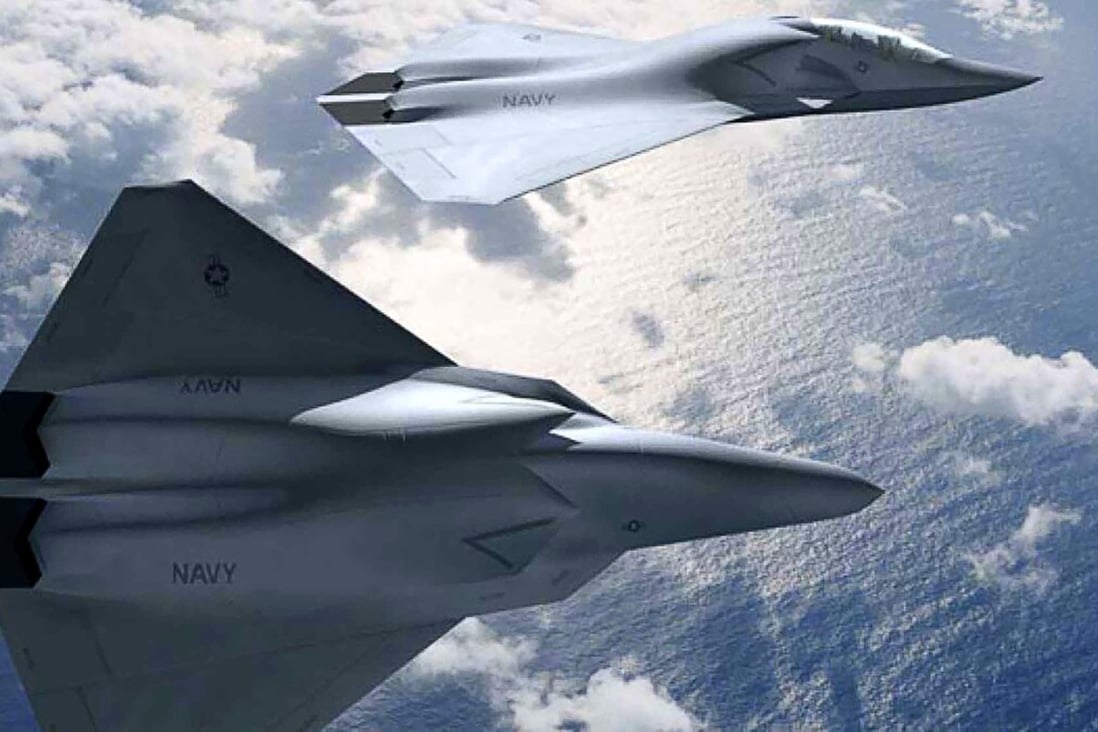China-US military rivalry: America’s cutting-edge NGAD programme aims to rise above PLA Air Force
- US fighters and autonomous drones would fight side by side under the new combat concept
- Air force advances in the US will push Beijing to match American ingenuity and design, analysts say
The US Air Force’s desire to radically reshape and accelerate the way it develops future fighter planes could propel China to ramp up its plans for next-generation aircraft, Chinese experts said.
A military insider familiar with China’s next-generation aircraft project said Chinese aircraft designers were keeping a close eye on anything disclosed by their American counterparts about NGAD, or the Next Generation Air Dominance (NGAD) programme.
If implemented, NGAD would create a network of advanced fighter aircraft, sensors and weapons, with jets and autonomous drones fighting side by side rather than as a single-aircraft platform or technology.
“China has also planned to develop a next-generation aircraft, but so far just specifically for the air force not for the navy, calling it a ‘background plane’,” said the insider, who requested anonymity.
“Because of a lack of reflection standards and relevant parameters, there are doubts around the development progress of the background plane.”
The US has announced two next-generation programmes: NGAD for the air force, and the F/A-XX for the navy, a long-term plan to develop next-generation ship-borne aircraft to complement and eventually replace the current F/A-18E/F Super Hornet fighters.
At a US Air Force Association symposium last week, General Mark Kelly, head of air combat command, said the air force needed to have its next-generation air dominance fighter soon if it wanted to compete with China.
“What I don’t know – and we’re working with our great partners – is if our nation will have the courage and the focus to field this capability before someone like the Chinese fields it and uses it against us,” he said.
“We just need to make sure we keep our narrative up and articulate the unambiguous benefit we’ve had as a nation to have that leading-edge technology ensuring we have air superiority for the nation and the joint force.”
Beijing-based military expert Zhou Chenming said Chinese aircraft designers would welcome US Air Force efforts to speed up the launch of NGAD fighters.
“Before making the direction of new aircraft, Chinese aircraft designers should clarify the parameters of their rival aircraft, especially the American fighters, including their combat range, speed, flying height and other dogfight capabilities, for basic reference,” he said.
The F-22 entered service in 2005, while China’s J-20 was launched in 2011 and formally joined the PLA Air Force in 2017. But China has failed to produce the WS-15 tailor-made engine designed for the J-20 fighters, and must still use the Russian AL-31F engine and its lesser home-made version, the WS-10C.
Steve Burgess, an aircraft specialist at the US Air War College, said the NGAD was aimed at developing a new fighter for the 2020s, a move to further reinforce the status of the US military as the global leader, as well as widen the gap between China and his country.
“Engine design problems will continue to hold China back [in their next-generation aircraft development programme],” he said, adding that Chinese aircraft technology still failed to threaten the US.
But Song Zhonging, a former PLA instructor, said China’s defence industry had more “privileges” than the US in terms of funding, compared with the strict budget approval process in the US.
US Congress has approved US$904 million of the air force’s US$1 billion request in the 2021 financial year, a sign of limited support by American lawmakers. In the 2020 financial year, the service received US$905 million for the programme.
Because of the high cost of an F-22 – about US$250 million – the last one was delivered in 2012. Amid criticism from taxpayers, the Pentagon decided to develop the inferior and lower-cost single-engine F-35 Lightning, for more than US$1 trillion over the 60-year lifespan of the programme, making it the most expensive weapons project in the American military.
“Thanks to the increasing pressure from the US … that has encouraged Chinese leadership to pour and mobilise all resources and manpower to strengthen the country’s defence industry,” Song said.
Russia has announced that the country’s two aerospace juggernauts Mikoyan (MiG) and JSC Sukhoi have joined hands to build a conceptual sixth-generation fighter jet, the MiG-41 interceptor, under the PAK DP programme.
Western European countries are trying to develop their own new-generation aircraft such as the Future Combat Air System and Tempest fighters.





No comments:
Post a Comment
Note: Only a member of this blog may post a comment.